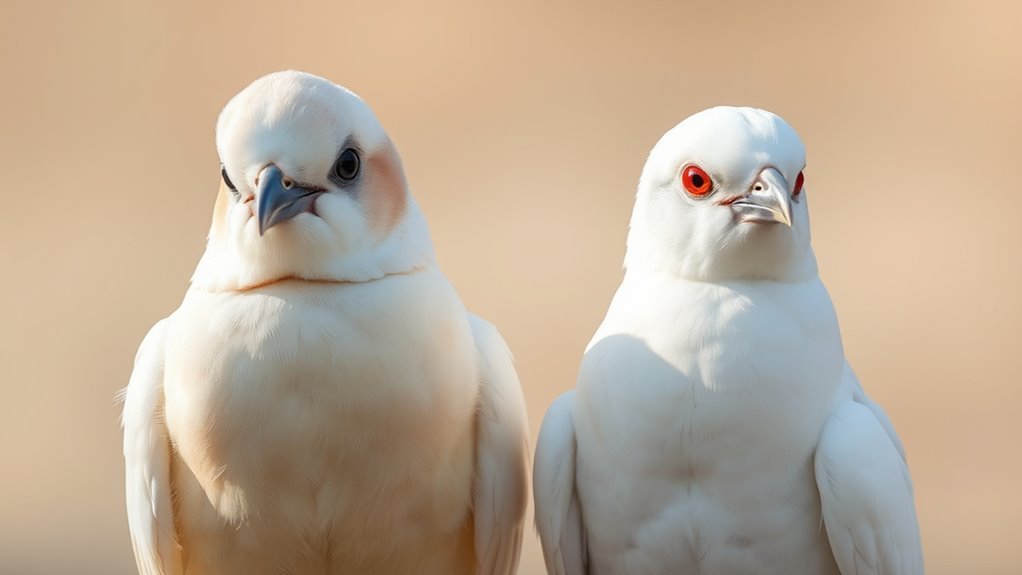Understanding Leucistic and Albino Birds
Leucistic and albino birds offer fascinating insights into genetics. Leucism reduces pigmentation, allowing birds to keep their normal eye color. In contrast, albinism completely removes melanin, creating strong color differences in the feathers and eyes. These variations not only change how the birds look but also affect their behavior and survival. Understanding these differences can help us learn more about their roles in nature and how they relate to other species.
Key Takeaways
- Leucism results in lighter plumage due to reduced pigmentation, while albinism leads to a complete absence of melanin, resulting in white feathers.
- Leucistic birds retain normal eye colors, while albino birds typically have pink or red eyes due to lack of melanin.
- Leucism and albinism arise from different genetic mutations affecting pigment production in birds.
- Leucistic birds can face social dynamics challenges, affecting their mating and predator evasion strategies.
- Both conditions highlight the genetic diversity within bird populations and contribute to understanding avian adaptation and behavior.
Defining Leucism in Birds

Leucism in birds is a genetic variation that affects their pigmentation. This condition results in leucistic plumage, which shows reduced color while the eye color remains normal. This differs from albinism, which lacks melanin entirely.
Examples of leucism can be found in various species, such as the snowy owl. These birds often have patchy white feathers, giving them a distinct look.
Leucism can change how a bird blends into its environment. This may affect how well it can escape predators and find mates.
Understanding leucism helps us appreciate the diversity in bird genetics and adaptations. This knowledge can deepen our connection with nature and enhance our appreciation for its beauty.
Defining Albinism in Birds
Albinism in birds is a genetic condition that results in a complete lack of melanin. This causes their feathers to be white and their eyes to appear pink or red. Albinism occurs due to specific genetic mutations that prevent the production of melanin, which can be inherited from parents.
Many people think of albinism as a rare genetic occurrence, but it's important to understand that it arises from distinct mutations affecting melanin production.
Seeing albino birds can be a fascinating experience. However, they face certain challenges, such as being more sensitive to sunlight. Recognizing these differences can help bird lovers appreciate their beauty while also understanding their care needs.
Sharing knowledge about albinism fosters community among bird enthusiasts and enriches the passion for these unique creatures.
Genetic Differences Between Leucism and Albinism

Leucism and albinism are two conditions that affect birds' appearance due to genetic differences.
Leucism results from genetic mutations that reduce pigmentation, allowing some colors to show in feathers, skin, and eyes. Birds with leucism can have darker eye colors.
On the other hand, albinism stems from mutations that stop melanin production, causing a complete lack of pigment. This leads to albino birds having pink or red eyes.
These conditions arise from different genetic processes. Understanding these differences helps us see how they shape a bird's look and behavior.
Both leucistic and albino birds add unique beauty to their surroundings. By appreciating these traits, we can enjoy the diversity of avian genetics more fully.
Visual Characteristics of Leucistic Birds
Leucistic birds have unique visual traits that distinguish them from fully pigmented birds. They've a partial loss of melanin, resulting in the following characteristics:
- White or very light feathers
- Pale skin tones with subtle color variations
- Dark eyes, which contrast with albino birds that have red or pink eyes
These features create a striking appearance. Observing leucistic birds allows you to appreciate the variety within bird species.
Their beauty stands out in both natural habitats and human-made settings. This awareness can deepen your appreciation for the diversity of avian life.
Visual Characteristics of Albino Birds

Albino birds have unique visual traits. They lack melanin, making their feathers appear completely white. This white plumage stands out in nature. Their eyes also lack color and often appear pink or reddish. This affects how they see colors.
In the wild, these birds struggle with camouflage, which is crucial for survival. Their bright appearance can make them more visible to predators. However, this visibility can help them attract mates or stand out in social groups.
Understanding these characteristics allows us to appreciate albino birds. It also helps us connect more with the avian community.
Behavioral Traits of Leucistic and Albino Birds
The bright feathers of albino birds affect their visibility and behavior. This unique appearance influences their social interactions and mating displays. Leucistic and albino birds often struggle to blend in with their environment, which impacts their social behavior.
Here are key behavioral traits:
- Increased vigilance: They're more alert to predators because of their noticeable colors.
- Altered mating rituals: Their distinctive look can either attract or repel mates, affecting courtship behaviors.
- Social dynamics: Their appearance may lead to exclusion or preference in flocks, shaping their social interactions.
Examining these traits helps us appreciate how these birds adapt and thrive despite their challenges.
Rarity and Occurrence in Nature
Leucistic and albino birds are rare due to genetic mutations that affect their color. These mutations stop normal pigmentation, making these birds less common in nature.
Most birds have colors that help them survive, like camouflage, which protects them from predators and aids in social interactions. Because leucistic and albino birds stand out, they face challenges in their environments.
This rarity shows how natural selection works and the difficulties that come with genetic differences.
Seeing these unique birds can deepen our appreciation for the variety of life and the rules that shape nature.
The Impact of Leucism and Albinism on Survival
Genetic mutations that cause leucism and albinism create distinct appearances in birds, but they also affect survival rates.
These conditions pose several challenges that impact their ability to avoid predators and adapt to their environments. Here are some key points:
- Visibility: Birds with lighter plumage are easier to see, which increases their risk of being hunted by predators.
- Temperature control: Without melanin, these birds may struggle with regulating their body temperature. This can make it difficult for them to survive in different climates.
- Social behavior: Unique traits can change how these birds interact with each other, affecting their nesting and social behaviors.
Frequently Asked Questions
Can Leucistic and Albino Birds Interbreed?
Leucistic and albino birds can interbreed. This means that pairs of these birds can have offspring together. The offspring may show different color mutations. These variations arise from their genetic makeup. Understanding these traits helps bird enthusiasts appreciate the diversity within bird species.
Are There Health Issues Associated With Leucism or Albinism?
Yes, leucism and albinism can lead to health issues. These conditions often cause vision problems, skin issues, and increased sensitivity to environmental conditions. These factors can affect the survival and ability of these individuals to adapt in the wild.
How Can I Identify Leucistic or Albino Birds in the Wild?
To identify leucistic or albino birds in the wild, focus on their color. Leucistic birds have lighter feathers but can show some color, while albino birds are entirely white with pink eyes. Look for differences in their behavior; they may struggle with camouflage. Their light colors can make them more visible to predators. Pay attention to their habitats; these birds might be found in areas where they can hide or have easy access to food. Observing these traits can help you spot these unique birds in their natural environment.
What Is the Origin of Leucism and Albinism in Birds?
Leucism and albinism in birds come from genetic mutations that affect how pigments are produced in their bodies. These conditions can make it hard for birds to blend into their surroundings, sometimes putting them at risk from predators. However, they can also attract potential mates or draw attention from humans, which can help in conservation efforts.
Do Leucistic and Albino Birds Have Different Lifespans Compared to Normal Birds?
Leucistic and albino birds face more threats in nature than normal birds. Their white or light-colored feathers make it hard for them to hide from predators. This can lead to higher chances of being hunted. Also, these birds may have health issues, which can affect their lifespans. As a result, they often live shorter lives than their normally colored counterparts. Providing safe habitats is crucial to support their survival and increase their chances of living longer.

Hello, I’m Emily Price, the founder of Birds Affection. As a passionate bird enthusiast and spiritual seeker, I’ve always been fascinated by the symbolic meanings and mystical connections between birds and our lives. On this website, I share my knowledge and insights on the spiritual significance of various bird species, exploring their roles as messengers, guides, and teachers. Through my writing, I aim to inspire and educate others on the profound wisdom and beauty that birds bring to our world. Join me on this journey as we delve into the enchanting realm of bird symbolism and discover the hidden meanings behind these magnificent creatures.







